最为经典的公示语翻译错误
公示语错误例子

公示语错误例子【篇一:公示语错误例子】为了认识详细情况,笔者组织学生走上街头进行实地察看,对哈尔滨市存在的公示语汉英翻译错误进行了检查解析,睁开了一次授课实践活动。
在实践授课中,学生们发现,城市的街头巷尾上各处充斥着公示语汉英翻译的错误。
包括商场及酒店旅店的牌匾、街路牌、银行及旅游景点指示牌等等。
经过对所发现的翻译错误进行总结,我们将主要错误分类以下:1.拼写错误例 1 美视达眼镜译为“mei shi da giass 〞眼镜应拼写为“glass 〞,而且应使用复数形式。
而且,依照?现代实用英语例解?,英语公示语的突出特色之一是常常所实用大写字母。
建议译为“meishida glasses 〞。
拼写错误在公示语翻译的全部错误中属于最先级的错误,简单的一个“glass 〞是小学生都会拼写的。
但令人遗憾的是,在我们身边此类错误俯拾皆是,在此就不一一赘述。
2.语法错误例 2 金太阳购物中心的广告语“创立流行,带动潮流〞译为“createtopdriven trend 〞其中的两个动词“创立〞和“带动〞,一个使用了动词原形“create 〞,一个使用了过去分词形式“driven 〞,而且“createtop 〞两词中间没有空格。
建议动词使用现在分词形式,名词“top 〞和“trend 〞前加定冠词,译为“creating the topdriving the trend 。
〞3.用词不当例 3 某一处售楼的广告语“大江岸上的院馆〞译为“museum of the hospital on shore dajiang 。
〞依照该楼盘的地址能够推测,“大江岸上〞指该处房产位于松花江边,翻译成“shoredajiang 〞会让外国人误解为“d ajirig 为另一条江的名字,而非松花江。
“hospital 一〞词的使用实在令人难懂,我们查阅了多部字典,该词只有“医院〞的意思。
试想一下,若是让外国读者看这那么广告的话,他们也许会以为是“医院博物馆〞的广告吧。
公示语汉译英翻译常见错误

公示语汉译英翻译常见错误word格式论文公示语汉译英翻译常见错误公示语汉译英翻译常见错误近年来,随着中国与国际间交往的日益密切,在政治、经济、文化、旅游等方面加快与其他国家的融合与共同发展,中国在打开国门加快经济建设的同时,也注重文化的建设,现代化的生活节奏与国际化的文化环境,既满足了国际旅游者,外交人员,商务人员等在中国经历和体验不同文化的需要,又提升国家或城市的自身形论文联盟象。
因此,对于到访的国际友人来说,要想让他们在中国有宾至如归的感觉,公共场所的英文公示语就显得非常重要,它明确地告诉信息接受者相关信息和友善提示。
所以,英文公示语对城市乃至国家的形象与对外宣传的影响显而易见。
毋庸置疑,在公共场所使用规范化的伴有英文的公示语对中国加快国际化进程将起到巨大的推动作用。
因此,正确的做好公示语英汉互译为外国友人提供便利的同时,展示良好的中国形象,已经成为伴随国际交流日益融洽过程中一件刻不容缓的事情。
如何使用恰当的词语及形式将公示语有关信息准确地传达给公众,是公示语汉英互译的关键所在。
公示语通常出现在醒目的位置,具有窗口的作用,其应用范围非常广泛, 几乎涉及到我们日常生活的各个方面, 如街头的路牌、广告牌、路标、商店招牌、警示语、宣传语、旅游简介等等。
作为一种交际工具,它用图标或文字与图标相结合等方式把必要的、有用的信息传达给大众,是人们生活中不可或缺的帮手。
word格式论文作为一种特定功能的文本形式,公示语应用历史久远,对其翻译研究意义深远。
在世界各民族的社会、文化、经济发展进程中,准确的公示语翻译对外籍人员来说,具有良好交际效果,可有效地对其规范社会行为,提高生产效率以及优化生存质量等方面。
由于公示语在传递信息中的语言特色和特殊功能,我们应该认清公示语翻译过程中可能出现的问题及背后的原因。
将极大地有助于翻译人员采取正确的翻译方法和翻译策略来解决问题。
要想解决以上问题,我们首先要了解公示语翻译研究趋势。
公示语错误例子

公示语错误例子【篇一:公示语错误例子】为了了解具体情况,笔者组织学生走上街头进行实地考察,对哈尔滨市存在的公示语汉英翻译错误进行了调查分析,开展了一次教学实践活动。
在实践教学中,学生们发现,城市的大街小巷上到处充斥着公示语汉英翻译的错误。
包括商场及酒店宾馆的牌匾、街路牌、银行及旅游景点指示牌等等。
通过对所发现的翻译错误进行总结,我们将主要错误分类如下:1.拼写错误例1美视达眼镜译为“mei shi da giass”眼镜应拼写为“glass”,而且应使用复数形式。
而且,根据《现代实用英语例解》,英语公示语的突出特点之一是往往全部用大写字母。
建议译为“meishida glasses”。
拼写错误在公示语翻译的所有错误中属于最低级的错误,简单的一个“glass”是小学生都会拼写的。
但令人遗憾的是,在我们身边此类错误比比皆是,在此就不一一赘述。
2.语法错误例2金太阳购物中心的广告语“创造流行,带动潮流”译为“createtopdriven trend”其中的两个动词“创造”和“带动”,一个使用了动词原形“create”,一个使用了过去分词形式“driven”,而且“createtop”两词中间没有空格。
建议动词使用现在分词形式,名词“top”和“trend”前加定冠词,译为“creating the topdriving the trend”。
3.用词不当例3某一处售楼的广告语“大江岸上的院馆”译为“museum of the hospital on shore dajiang”。
根据该楼盘的位置可以推测,“大江岸上”指该处房产位于松花江边,翻译成“shoredajiang”会让外国人误解为“d ajir ig 为另一条江的名字,而非松花江。
“hospital”一词的使用着实令人费解,我们查阅了多部字典,该词只有“医院”的意思。
试想一下,如果让外国读者看这则广告的话,他们也许会认为是“医院博物馆”的广告吧。
城市公示语翻译的错误类型及解决措施
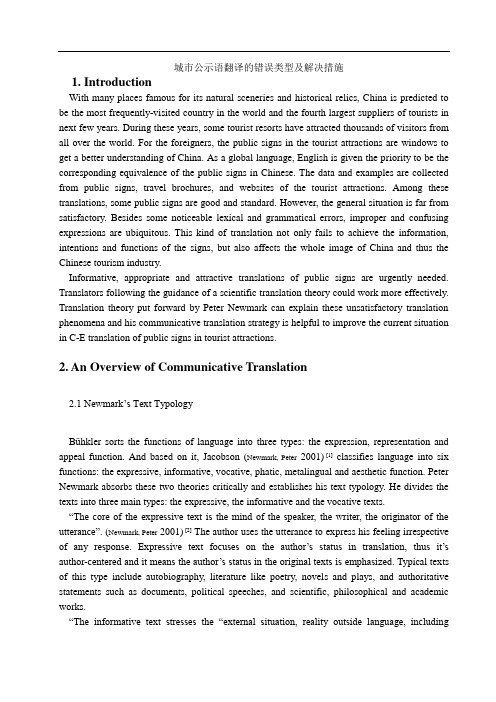
城市公示语翻译的错误类型及解决措施1. IntroductionWith many places famous for its natural sceneries and historical relics, China is predicted to be the most frequently-visited country in the world and the fourth largest suppliers of tourists in next few years. During these years, some tourist resorts have attracted thousands of visitors from all over the world. For the foreigners, the public signs in the tourist attractions are windows to get a better understanding of China. As a global language, English is given the priority to be the corresponding equivalence of the public signs in Chinese. The data and examples are collected from public signs, travel brochures, and websites of the tourist attractions. Among these translations, some public signs are good and standard. However, the general situation is far from satisfactory. Besides some noticeable lexical and grammatical errors, improper and confusing expressions are ubiquitous. This kind of translation not only fails to achieve the information, intentions and functions of the signs, but also affects the whole image of China and thus the Chinese tourism industry.Informative, appropriate and attractive translations of public signs are urgently needed. Translators following the guidance of a scientific translation theory could work more effectively. Translation theory put forward by Peter Newmark can explain these unsatisfactory translation phenomena and his communicative translation strategy is helpful to improve the current situation in C-E translation of public signs in tourist attractions.2. An Overview of Communicative Translation2.1 Newmark‟s Text TypologyBühkler sorts the functions of language into three types: the expression, representation and appeal function. And based on it, Jacobson (Newmark, Peter2001) [1]classifies language into six functions: the expressive, informative, vocative, phatic, metalingual and aesthetic function. Peter Newmark absorbs these two theories critically and establishes his text typology. He divides the texts into three main types: the expressive, the informative and the vocative texts.“The core of the expressive text is the mind of the speaker, the writer, the originator of the utterance”. (Newmark, Peter 2001) [2] The author uses the utterance to express his feeling irrespective of any response. Expressive text focuses on the author‟s status in translation, thus it‟s author-centered and it means the author‟s status in the original texts is emphasize d. Typical texts of this type include autobiography, literature like poetry, novels and plays, and authoritative statements such as documents, political speeches, and scientific, philosophical and academic works.“The informative text stresses the“external situation, reality outside language, includingreported ideas or theories”. (Newmark, Peter 2001) [2] The information is what the author intends to deliver to the reader or audience. Textbooks, technical reports, articles in newspapers or periodicals, public signs, scenic spots introductions, scientific papers, and thesis are typical of the informative text.The function of the vocative text is to “call upon the readership to act, think or feel, in fact to …react‟ in the way intended by the text”. (Newmark, Peter2001)[2]According to Newmark, two factors are essential to the vocative texts, namely, the relationship between the reader and the writer, the comprehensibility and readability of the texts. Typical vocative texts include notices, instructions, publicity, advertisements, and persuasive writing.Although a text of pure function and purpose can seldom be found, from a broader perspective, texts can be all classified into these three types. And to different types of text, according to Newmark, two kinds of translation strategies can be applied.2.2Communicative Translation V.S. Semantic TranslationThe main concern of translation theory is to determine appropriate translation methods for the widest possible range of text. The long dispute over the chosen between literal translation and liberal translation can be ended by Newmar k‟s translation theory. The two translation strategies proposed by Newmark are appropriate to any text based on his text typology, i.e. communicative and semantic translation. Communicative translation attempts to produce on its readers an effect as close as possible to that obtained on the readers of the original; and semantic translation attempts to render, as closely as the semantic and syntactic structures of the second language allow, the exact contextual meaning of the original. Eugene Nida (Newmark, Peter 2001)[2]comments that Newmark‟s major contribution to translation is putting forward communicative and semantic translation. And the distinction becomes especially relevant for the diversity of texts.The goal of communicative translation is to produce the same effect on the TL readers as that produced by the original texts on the ST readers. Instead of just mirroring the words of ST, communicative translation maintains that the translation should be target language-oriented in the aspect of linguistics, culture and pragmatics. It caters more to the TL readers by producing the messages of the original. Thus readability and naturalness are the criteria for communicative translation. By restructuring or rearranging the clause and reinforcing the emphasis, the translator has the right and responsibility to meet the criteria.To help readers to fully comprehend the text, communicative translation makes the translation closer to them and transfers the social value, cultural elements and language peculiarities imbued in the original text into the TL translation. Thus the translator is given more liberty dealing with the source text. He/she can reset the sentences to serve in the interests of the target reader when thinking that translating the original text which is somewhat awkward or liable to cause misunderstandings in the original sentence sequence.Communicative translation is applied when non-authoritative texts are translated, taking public signs in tourist attractions for example.In contrast, semantic translation is a mode of text transfer which involves using only syntactic and semantic constrains of the TL to duplicate the exact contextual meaning the author intends. It focuses on the semantic content of the SL text and attaches equal importance to the style of the text. Priority is given to the meaning and form of the original. When translating authoritative texts, including literature, religious texts and legal texts, the translator should apply the methodof semantic translation.According to Newmark, communicative translation is applied for “informative” and “vocative” texts, and semantic translation is for “expressive” text. Although the two strategies are different from each other, he remarks that “communicative an d semantic translation may well coincide” because actually there are overlaps of communicative and semantic translation methods. There is no clear-cut line separating semantic translation from communicative translation, nor is there an indicator showing which part of a text is expressive, informative or vocative. The two methods are complementary in dealing with specific translation problems and the three text types are mingled with one another in a text. But some texts intend to lay particular stress on one text type, some others on another. Therefore, a translation can be more or less communicative or more or less semantic.3. An overview of public signs3.1The Definition of Public Signs“Public signs” is new general fashionable vocabulary which is verbal language read in public. The public signs are the words and image information including instructions,; display; alarming and etc., that relate to live hood; manufacture and life.(Hefa Lv,2005;9)[3]Public signs have great range of usage, and deep into all aspects of life. Guideboard, advertising board, road sign, shop signs, warnings, slogan, tourist attractions introduction and ect., All reflects the overall quality of the society and self-cultivation and mental attitude.3.2The classification of Public SignsZongsheng Dai and Hefa Lv point it out that there are 4 functions of public signs are Directive; prompting function; Restrictive;Mandatory. ( Wang Yin Hefa Lv 2007) [4]3.2.1 Directive functionDirective function: directive function that is not restrictive and mandatory provides thoughtful information services and it asks not the actions taken by readers, however, it just uses to indicate content of service. For examples:Conference Center: 会议中心Washing Bay: 洗车场International Departure: 国际出发Super Market: 超级市场These public signs have been significantly used in cities or facilities of tourist attraction and religious clubs and foreign institutions and etc.. Lots of nouns are used in language style showing “Static State” information.3.2.2 Promoting FunctionThe major purpose of promoting public signs is to promote the readers, but has no particular meaning. The usage of these is wide enough, such as:Check In:入住登记Admission Free: 免费入场Cable Car Entrance: 缆车入口Smoke-Free Scenic Area:无烟景区Verbs phrase and noun phrase that is characterized by few words and easy identification are applied in this public signs.3.2.3 Restricted FunctionRestricted public signs are always straightforward in wording with a view to constrict and limit relative actions of common people. For instance:Ticket Only: 凭票入场Keep Silence: 保持安静Give Way to Buses: 公交优先Keep Distance :保持车距3.2.4 Mandatory FunctionRestricted signs require correlation public to take actions or not to take any actions. The language features are frank and the tones is stiff and prohibit firsthand and order people to take some certain actions. Like:No Parking: 禁止停车No Littering: 请勿乱扔废弃物No Smoking: 禁止吸烟“As for the pragmatic function of public functions, the ecological and environmental protection is also the vital function, excepting the 4 functions above”(王银泉.2007,5) [5]. Like “ Don‟t pick flowers”, “ Shopping with cloth bag is fashionable” and etc. Public signs which are simple, specified; standard; and etc. connect the specification patterns and personalization so as to become a special social dialect. It‟s aiming at restrain the public such as calling people to obey the social morality, and prohibiting any actions that do harm to the public.4. The translation problems of public signs4.1 Linguistic translation errors (pragmatic errors)Finding linguistic translation errors that means linguistic translation itself has no problems; linguistic translation errors are not easy to be noticed in that it differs from grammatical errors which just does not comply with idiomatic expression of target language, or occurs in improper context so that the readers feel confused and unsatisfied. The grammatical errors may be caused by authors low language proficiency; carelessness. All of this can be avoided. However, linguistic translation errors are elusive and hard to discover so that the results caused by it is more severe than grammatical errors.Grammatical errors wo n‟t produce side effect on readers, nevertheless, Linguistic translation errors are likely to cause mistakes, what is worse, the errors like that may hurt readers or make readers laugh. As an old saying says“Grammatical errors”indicates that speakers do not have good command of language, but linguistic translation errors manifest the quality of speakers.Let‟s view some typical examples of public signs. “闲人免进” is translated into “No Lazy People” . This kind of translation method which is funny only is milli on miles away from the meaning from original one. The standard one is “Staff only”. “出口” is translated into“Export”. As a result, it becomes another one“出口”.The accurate translation is “Exit”. “欢迎再次光临” is translated into“Welcome You Again”. This kind of version makes friends of foreign countries feel unfriendly and polite and confused. Idiomatic translation of this is “Welcome Back”.Figure 1. Common non-standard public signs“小心路滑”is translated into“Carefully slide”which is totally another meaning. The right one is “Caution, Wet Floor”.Figure 2. Common non-standard public signs“请勿吸烟” is translated into“Thank you for not smoking”which is not idiomatic and demoded. The most idiomatic one is “No Smoking”.4.2 The classification of public signs4.2.1 MisspellingThis kind of error includes increasing or decreasing alphabet when spelling; spelling some words separately, and wrong writing or incorrect spelling. For example,PIC 1-3Figure 3. Common non-standard public signsThe clothing in shop is translated into “Womenswear”(女装); actually the correct translation is “Ladies‟ dress”. “太和门” is translated into “Gate of Supreme Harmony”. The exact translation is“Gate of Supreme Harmony”4.2.2 Grammatical errorsThe second one is grammar errors. Single or plural forms, tense, voice and agreement of categories are the elements which frequently cause problems in Chinese to English translation.Figure 4. Common non-standard public signsFor example, “严禁随地吐痰” is translated into “Rigorous spit everywhere” instead of “No Spitting” or “Please Don‟t Spit”.Grammatical errors are the most common error of public signs translation, for instance, the improper use of singular and plural of noun; tenses of verb are wrong; wrong usages of verbs and noun and etc. The following is the common misuse of public signs:Figure 5. Common non-standard public signs“女卫生间”is translated into “Woman”. This sentence wants to focus on the “plural”. First, it should be “Women”, second, it is not comply with international standard. The accurate and authentic translation of this is “Ladies”. “请勿乱对垃圾”is translated into “No Litter”. The verb “litter” is adopted in a wrong way. It should be“No Littering”.Figure 6. Common non-standard public signsFigure 7. Common non-standard public signs“男卫生间” is “MAIE” which incorrectly uses incorrectly singular and plural of noun. It should be “Gents”. “女卫生间”is“FAMAIE”which incorrectly uses incorrectly singular and plural of noun. It should be “Ladies”.The crucial reason for this error is that the translator is not qualified who can not use the method of application of public signs well so as to cause low-level grammatical errors. Of course, but more often, it belongs to translator‟s carelessness, or the translator has no time to check and review since time is tight.4.2.3 Lexical errorsLexical errors cover: collocation error; mixing synonyms; semantic ambiguity and etc. The exit of some shopping mall says “欢迎您再来” which is translated into “Welcome you to come”, however, the collocation of “Welcome‟‟ is not right. The proper translation is “We Welcome You to Come Back” or “Please come agai n﹗” “铜陵市支行” which is put into “TONGLING SHI COUNTRY SUB BRANCH” the sign mixes English and Chinese up and uses both o f the two languages to translate. “TONGLING CITY‟‟ should be used instead of “TONGLING SHI‟‟ And , using “branch‟‟ is enough to convey the meaning “支行‟‟, so it is cumbersome to add “sub”. The version “TONGLING CITY BRANCH‟‟ is accepted.4.2.4 Cultural translation errorsIt is impossible to separate the use of a language from the culture in which the language is deeply embedded. The interwoven relationship between language and culture has a dual sense. Language is a part of culture and plays a very important role in it.4.2.5 Unidiomatic ExpressionsCustom culture refers to a kind of custom resulting from long-period social life and activities. There are so many aspects being different between English and Chinese, such as greeting, appellation, giving thanks, apologizing, complimenting and making phones. For instance, when people greet others, Chinese people always ask:“Have you finished your work?”“Where are you going?”“What are you doing”By contrast, in western culture, there are real question, so they will feel weird and think“will you be ready for my dinner?”“Where am I going and what am I doingis none of your business.”Figure 8. Common non-standard public signsExample 2, English version: ORGANISM, the meaning of Chinese words and identity are always obscure and the readers have to understand the whole writing from the context. The right one is “Unrecyclable”4.2.6 ChinglishIt‟s word-for-word translation among which some are called Chinglish. This may lead to misunderstandings by the foreigner s. For example, “上楼”is translated into “Up Stair”. Though there is no error and it does express the literal meaning of the Chinese, it does not in accordance with language habits of English thus loses the function of direction.Taking words literally is considerate into Chinglish which means mechanical translating words by words and sitting by number. It does not take the lexical connotation and order of English which causes a whale of a difference between the native English and translation version. Take so me scenic spots translation for example: “注意安全” is interpreted into “notice safety” which is said “注意” is “notice” and “安全” becomes “safety” more instances like below:(1)必须安全带帽。
旅游景点英译公示语语用失误例析

旅游景点英译公示语语用失误例析旅游景点英译公示语是指在旅游景点中使用的公示语,它是游客获取信息、导向方向、了解景点特色的主要途径。
由于语言和文化差异,翻译时经常出现语用失误,给游客的理解和体验带来困扰甚至误导。
下面是一些旅游景点英译公示语语用失误例析。
例1:中文原文:请勿触摸雕塑。
英文译文(错误):Please don't touch the sculpture.问题分析:这个例子中,译者直接翻译了中文的“触摸”一词,但在英文中,更常用的表达方式是“touch”,它有触摸、碰触的意思,但刻意追求触摸的程度和方式可能更合适。
所以译文应该改为:“Please don't touch the sculpture with your hands.”例3:中文原文:淋浴时间限制15分钟。
英文译文(错误):Shower time is limited to 15 minutes.问题分析:这个例子中,“淋浴时间限制15分钟”这个信息是想告诉游客在淋浴时限制时间为15分钟,但是译文中的“limited to”给人一种不提倡超过15分钟的感觉,给游客留下了误导。
所以译文应该改为:“Please limit your shower time to 15 minutes.”例5:中文原文:报警电话110。
英文译文(错误):Emergency call 110.问题分析:在中文中,“报警电话”是指报警所使用的电话号码,但在译文中的“Emergency call”更像是表示发生紧急情况时打电话,而不是向游客告知报警电话号码。
所以译文应该改为:“Dial 110 for emergencies.”。
旅游景点英译公示语语用失误例析
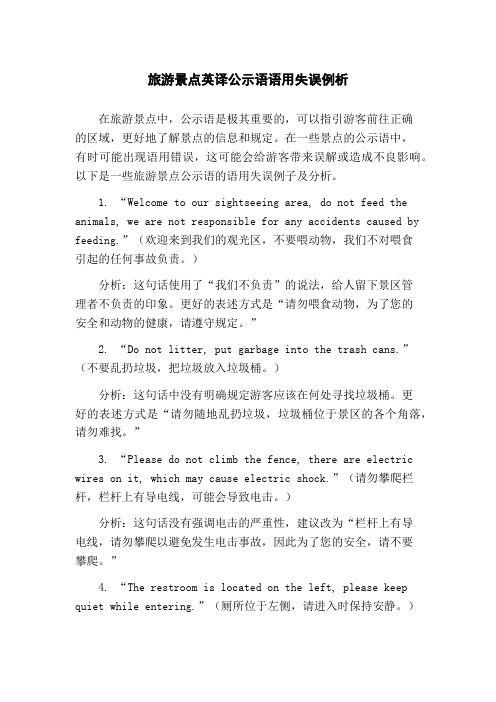
旅游景点英译公示语语用失误例析在旅游景点中,公示语是极其重要的,可以指引游客前往正确的区域,更好地了解景点的信息和规定。
在一些景点的公示语中,有时可能出现语用错误,这可能会给游客带来误解或造成不良影响。
以下是一些旅游景点公示语的语用失误例子及分析。
1. “Welcome to our sightseeing area, do not feed the animals, we are not responsible for any accidents caused by feeding.”(欢迎来到我们的观光区,不要喂动物,我们不对喂食引起的任何事故负责。
)分析:这句话使用了“我们不负责”的说法,给人留下景区管理者不负责的印象。
更好的表述方式是“请勿喂食动物,为了您的安全和动物的健康,请遵守规定。
”2. “Do not litter, put garbage into the trash cans.”(不要乱扔垃圾,把垃圾放入垃圾桶。
)分析:这句话中没有明确规定游客应该在何处寻找垃圾桶。
更好的表述方式是“请勿随地乱扔垃圾,垃圾桶位于景区的各个角落,请勿难找。
”3. “Please do not climb the fence, there are electric wires on it, which may cause electric shock.”(请勿攀爬栏杆,栏杆上有导电线,可能会导致电击。
)分析:这句话没有强调电击的严重性,建议改为“栏杆上有导电线,请勿攀爬以避免发生电击事故,因此为了您的安全,请不要攀爬。
”4. “The restroom is located on the left, please keep quiet while entering.”(厕所位于左侧,请进入时保持安静。
)分析:这句话中没有明确规定游客应该如何保持安静,更好的表述方式是“请进入时保持安静,避免影响其他游客和附近的居民。
公示语翻译错误示例1

• My goodness, they are expecting foreign visitors to decipher their funny signage. I believe the encoded message is do not enter the grass field (我是小 草) for photo taking (你的倩影).
English term (not Chinglish) accepted in the English dictionary. Instead of using sampan, a truly Chinese term, they created a Chinglish term, paddle boat. • Fishing boats and sampans are strictly not allowed to carry tourists.
• Location: The Great Wall, China. • 地点: 中国,万里长城。 • Hilarious Rating 搞笑度: 3/5 • 一流古迹,三流英文。
• Life’s good. (LG tagline!) Do not cross protective railings.
• Location: The City Wall, Xi’an China. • Bicycle is not allowed to use ramps.
• No graffiti for preserving cultural relics • No spitting for protecting your health.
• Constructio n ahead, Safety first
职场英语,最为经典的公示语翻译错误二
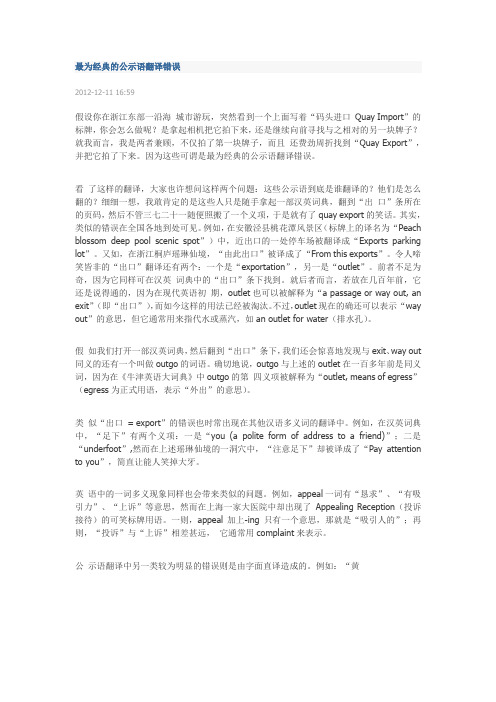
最为经典的公示语翻译错误2012-12-11 16:59假设你在浙江东部一沿海城市游玩,突然看到一个上面写着“码头进口Quay Import”的标牌,你会怎么做呢?是拿起相机把它拍下来,还是继续向前寻找与之相对的另一块牌子?就我而言,我是两者兼顾,不仅拍了第一块牌子,而且还费劲周折找到“Quay Export”,并把它拍了下来。
因为这些可谓是最为经典的公示语翻译错误。
看了这样的翻译,大家也许想问这样两个问题:这些公示语到底是谁翻译的?他们是怎么翻的?细细一想,我敢肯定的是这些人只是随手拿起一部汉英词典,翻到“出口”条所在的页码,然后不管三七二十一随便照搬了一个义项,于是就有了quay export的笑话。
其实,类似的错误在全国各地到处可见。
例如,在安徽泾县桃花潭风景区(标牌上的译名为“Peach blossom deep pool scenic spot”)中,近出口的一处停车场被翻译成“Exports parking lot”。
又如,在浙江桐庐瑶琳仙境,“由此出口”被译成了“From this exports”。
令人啼笑皆非的“出口”翻译还有两个:一个是“exportation”,另一是“outlet”。
前者不足为奇,因为它同样可在汉英词典中的“出口”条下找到。
就后者而言,若放在几百年前,它还是说得通的,因为在现代英语初期,outlet也可以被解释为“a passage or way out, an exit”(即“出口”),而如今这样的用法已经被淘汰。
不过,outlet现在的确还可以表示“way out”的意思,但它通常用来指代水或蒸汽,如an outlet for water(排水孔)。
假如我们打开一部汉英词典,然后翻到“出口”条下,我们还会惊喜地发现与exit、way out 同义的还有一个叫做outgo的词语。
确切地说,outgo与上述的outlet在一百多年前是同义词,因为在《牛津英语大词典》中outgo的第四义项被解释为“outlet, means of egress”(egress为正式用语,表示“外出”的意思)。
旅游景点英译公示语语用失误例析

旅游景点英译公示语语用失误例析旅游景点的英文公示语有时候会出现语用失误,下面就举几个例子来分析。
1. “欢迎您参观我们的公园,感受大自然的美妙。
”错误:在英文中,使用感觉动词feel是不符合语用的。
更正:改为“Welcome to visit our park and enjoy the beauty of nature。
”或者“Welcome to our park and experience the magnificence of nature。
”2. “这是一个适合亲子游的度假村。
”错误:英文中不使用亲子游这种词汇。
更正:改为“This is a family-friendly resort。
”3. “请您注意保护环境,不要随便丢垃圾。
”错误:使用please注意,太过婉转。
更正:改为“Please do not litter and help us keep the environment clean.”4. “希望您玩得开心!”错误:在英文中,这句话显得有点口语化,不符合公示语的规范。
更正:改为“Hope you enjoy your visit!”或者“We wish you a happy trip!”5. “美食街集美食、娱乐、休闲于一体。
”错误:使用了“娱乐”和“休闲”这样的词汇,使得信息不够清晰。
更正:改为“Food street offers a variety of tasty foods for your enjoyment.”总之,在翻译英语公示语的时候,应该以符合规范和语用清晰为前提,力求简洁明了。
2015华电翻译杯全国首届公示语翻译(英语)纠错大赛案例(范本)
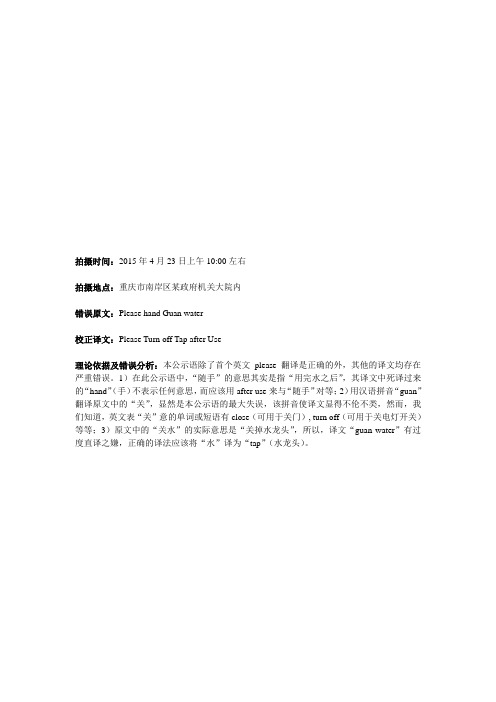
拍摄时间:2015年4月23日上午10:00左右
拍摄地点:重庆市南岸区某政府机关大院内
错误原文:Please hand Guan water
校正译文:Please Turn off Tap after Use
理论依据及错误分析:本公示语除了首个英文please 翻译是正确的外,其他的译文均存在严重错误。
1)在此公示语中,“随手”的意思其实是指“用完水之后”,其译文中死译过来的“hand”(手)不表示任何意思,而应该用after use来与“随手”对等;2)用汉语拼音“guan”翻译原文中的“关”,显然是本公示语的最大失误,该拼音使译文显得不伦不类,然而,我们知道,英文表“关”意的单词或短语有close(可用于关门), turn off(可用于关电灯开关)等等;3)原文中的“关水”的实际意思是“关掉水龙头”,所以,译文“guan water”有过度直译之嫌,正确的译法应该将“水”译为“tap”(水龙头)。
公示语汉译英误译分析
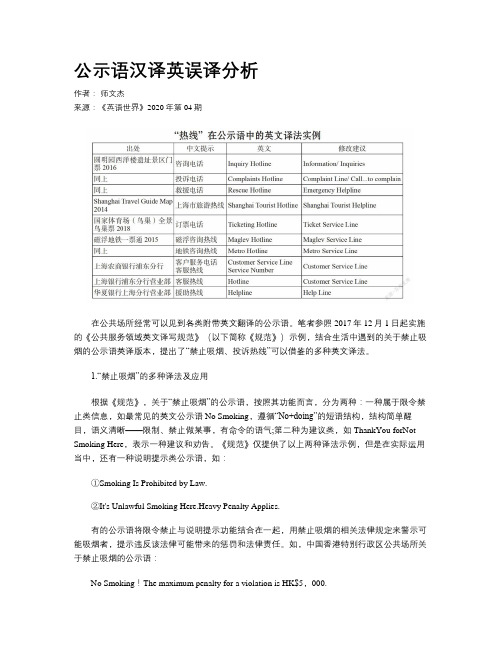
公示语汉译英误译分析作者:师文杰来源:《英语世界》2020年第04期在公共场所经常可以见到各类附带英文翻译的公示语。
笔者参照2017年12月1日起实施的《公共服务领域英文译写规范》(以下简称《规范》)示例,结合生活中遇到的关于禁止吸烟的公示语英译版本,提出了“禁止吸烟、投诉热线”可以借鉴的多种英文译法。
1.“禁止吸烟”的多种译法及应用根据《规范》,关于“禁止吸烟”的公示语,按照其功能而言,分为两种:一种属于限令禁止类信息,如最常见的英文公示语No Smoking,遵循“No+doing”的短语结构,结构简单醒目,语义清晰——限制、禁止做某事,有命令的语气;第二种为建议类,如ThankYou forNot Smoking Here,表示一种建议和劝告。
《规范》仅提供了以上两种译法示例,但是在实际运用当中,还有一种说明提示类公示语,如:①Smoking Is Prohibited by Law.②It's Unlawful Smoking Here.Heavy Penalty Applies.有的公示语将限令禁止与说明提示功能结合在一起,用禁止吸烟的相关法律规定来警示可能吸烟者,提示违反该法律可能带来的惩罚和法律责任。
如,中国香港特别行政区公共场所关于禁止吸烟的公示语:No Smoking!The maximum penalty for a violation is HK$5,000.另外,吸烟不仅包括实体烟,也包括电子烟(vaping or e-cigarettes),所以在一些禁止吸烟的公示语中也会有禁止电子烟的提示:No Smokingor Vaping.又如,在英国一个游船上,禁烟公示语明确提示,禁烟种类包括实体烟和电子烟,禁烟的空间范围包括船上和码头上:We operate a NoSmoking policy including e-cigarettes.on our vessels and piers.宾馆设有“无烟房”,英文翻译为smoking free rooms或者non-smokingrooms。
公示语翻译错误示例之二

Location: Shanghai China This one is cool ! Call the police when you are stolen by a thief. 一旦失窃要报警 Report to police for any thievery. 切莫姑息又养奸 Do not let the criminals get off scot-free. Do not let the criminals go free. Do not let the criminals escape the law and unpunished.
This kind of Chinese sign is quite common in Malaysia even before China opened up in 1978. Usually”来也匆匆, 去也冲冲” is written informally on the wall or door without such funny Chinglish translation. Direct translation, “Come in hurry,flush before you go.” Please flush before leaving.
Location: Bus Station, Qingdao China. 饮水处 Water Dispenser 重点旅客候车室 VIP Waiting Room
运动系列
Archery
Water Polo
餐服系列
The translator must be a joker to translate “a time sex” as “一次性”. Disposable shoe cover
论公示语翻译中的常见错误

论公示语翻译中的常见错误公示语双语翻译是每个城市对外宣传交流的一种重要途径,能够鲜明得表现出一座城市的软文化实力。
英译公示语时,我们需要了解中英语言文化的差异以及避免社交环境下的语用错误,才能展现出公示语应有的功能。
本文分析了公示语翻译的常见语用错误、过度翻译现象,总结了翻译公示语的方法策略,规范正确的公示语翻译对国家间的文化交流、经济发展的作用不容小觑。
标签:公示语;语用错误;过度翻译;翻译策略一、引言公示语是生活中最常见的“语言”,是一种公开面向公众的,以达到某种交际目的的指示性文字。
在我们的生活中,公示语随处可见,被广泛使用在路标、广告牌、公共场所的宣传语、旅游概况等地方。
公示语是国际化城市、旅游目的地语言环境、人文环境的重要组成部分。
因为公示语在公众和旅游参观者的生活中具有重要意义,所以如果对公示语有任何误解、滥用,都可能产生不必要的麻烦。
翻译不当可能影响到一个城市和地区的形象以及对外交流,并可能对外国游客造成许多不利影响。
在公示语翻译的实践中,必须考虑到文化差异、公示语的特点。
二、汉英公示语翻译常见的错误类型公示语常见的翻译错误类型有:过度翻译,语用失误等。
(一)过度翻译过度翻译是指忽视了翻译的基本原则,尊重原文。
公示语过度翻译的字面表现有:(1)词汇过度翻译Over-translated:翻译超出了原先的信息量,就会显得冗余、重复。
比如说:注意安全CAUTION DANGER;正确译法应该是CAUTION,这一词本身就代表了让人对于危险要小心谨慎,不需要再译出一个重复意义的词。
英汉语言的差异性,通常会造成公示语翻译时词汇层面上的累赘重复(Wordy)。
根据The free dictionary 的释义,此处的Wordy可理解为:包含公示语意义的词汇量超过所需词汇量。
少数单词即可达意,但追求词汇形式的对等而不注重文化语境的要求,采用了生硬重复的译法。
词汇过度翻译常常表现为同义词或叠词、行政区域名称以及某些介词的生硬翻译。
公示语汉译英翻译常见错误

公示语汉译英翻译常见错误word格式论文公示语汉译英翻译常见错误公示语汉译英翻译常见错误近年来,随着中国与国际间交往的日益密切,在政治、经济、文化、旅游等方面加快与其他国家的融合与共同发展,中国在打开国门加快经济建设的同时,也注重文化的建设,现代化的生活节奏与国际化的文化环境,既满足了国际旅游者,外交人员,商务人员等在中国经历和体验不同文化的需要,又提升国家或城市的自身形论文联盟象。
因此,对于到访的国际友人来说,要想让他们在中国有宾至如归的感觉,公共场所的英文公示语就显得非常重要,它明确地告诉信息接受者相关信息和友善提示。
所以,英文公示语对城市乃至国家的形象与对外宣传的影响显而易见。
毋庸置疑,在公共场所使用规范化的伴有英文的公示语对中国加快国际化进程将起到巨大的推动作用。
因此,正确的做好公示语英汉互译为外国友人提供便利的同时,展示良好的中国形象,已经成为伴随国际交流日益融洽过程中一件刻不容缓的事情。
如何使用恰当的词语及形式将公示语有关信息准确地传达给公众,是公示语汉英互译的关键所在。
公示语通常出现在醒目的位置,具有窗口的作用,其应用范围非常广泛, 几乎涉及到我们日常生活的各个方面, 如街头的路牌、广告牌、路标、商店招牌、警示语、宣传语、旅游简介等等。
作为一种交际工具,它用图标或文字与图标相结合等方式把必要的、有用的信息传达给大众,是人们生活中不可或缺的帮手。
word格式论文作为一种特定功能的文本形式,公示语应用历史久远,对其翻译研究意义深远。
在世界各民族的社会、文化、经济发展进程中,准确的公示语翻译对外籍人员来说,具有良好交际效果,可有效地对其规范社会行为,提高生产效率以及优化生存质量等方面。
由于公示语在传递信息中的语言特色和特殊功能,我们应该认清公示语翻译过程中可能出现的问题及背后的原因。
将极大地有助于翻译人员采取正确的翻译方法和翻译策略来解决问题。
要想解决以上问题,我们首先要了解公示语翻译研究趋势。
学校公示语翻译
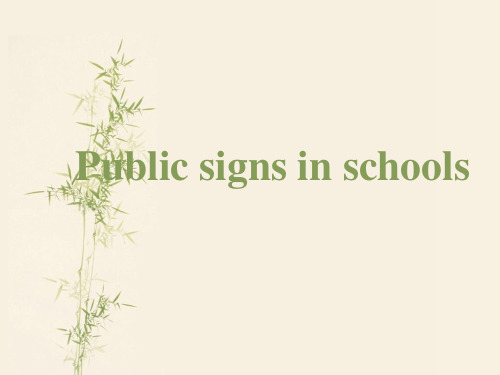
Cross Traffic: Do Not Stop
提供性表达: No Watching When Walking No Walking When Watching
Caution: Wet Floor
提供性翻译: Don’t Hurt Me for Your Pretty.
Slowly:Accident Prone Area
提供翻译: No food from outside
表达错误:
注意安全: Attention security 提供翻译: Caution!
正确翻译:
禁止倚靠: Leaning on the door prohibited
当心夹手: Mind your hand
一条通道: One way
提供性翻译:Unrecyclable
正确翻译 Electromobile Entrance
正确翻译
women
men
Digital Resources
Comprehensive Management Section
中文图书阅览室
Reading Room Chinese Edition
研究室
of
Study Room
工具书厅 Reference Room 存包间 Deposit Room
自习区
Individual Study
中外文报刊阅览厅 Newspapers & Periodicals 杨武能图示文献资料馆 W. Yangs Bibliothek & Archiv 馆长室 Librarian’s Office 会议室 Meeting Room
提供性翻译: You Love Me, Please Don’t Hurt Me. 提供性翻译: Think about It, Grass is Growing
旅游景点英译公示语语用失误例析

旅游景点英译公示语语用失误例析在旅游景点,英文公示语是游客们获取信息的重要途径之一。
由于语言和文化的差异,有时英文公示语可能存在一些语用失误。
本文将通过例析的方式,总结一些常见的旅游景点英译公示语语用失误,供大家参考。
1. 语法错误例如:Welcome to our park. Please not step on the grass.这句话的正确翻译应该是:请不要踩草坪。
在这个例子中,英文公示语中存在语法错误,正确的表达方式应该是“Please do not step on the grass.”。
这是一个典型的语法错误,可能会给外国游客带来困扰或者误解。
公示语应该避免语法错误,以免引起混淆或误解。
这个例子中,英文公示语的翻译虽然没有语法错误,但却存在语意模糊的问题。
在实际使用中,游客可能不清楚“beyond”是什么意思,导致误解或者无法准确理解。
公示语在翻译时应该尽量避免使用模糊或者不清晰的词语,以确保游客能够准确理解。
3. 文化差异例如:喀纳斯秘境欢迎您的到来。
这句话的正确翻译应该是:Welcome to Kanas Paradise.在这个例子中,英文公示语的翻译虽然基本正确,但是在表达上存在文化差异。
中文“秘境”和英文“Paradise”在语境和文化上有所区别,可能会给外国游客造成困扰。
公示语在翻译时应该考虑目标语言的文化和语境,避免因文化差异而引起误解或困惑。
在这个例子中,英文公示语的翻译存在数字单位错误。
中国和西方国家的日期表达方式存在差异,如果未正确转换数字单位,容易引起误解。
公示语在翻译时应该将数字单位转换为目标语言的习惯表达方式,以确保准确传达信息。
这个例子中,英文公示语的表达方式比较生硬,缺乏礼貌和善意。
在英文中,使用“Please do not…”的方式会更显得礼貌和友好,能够更好地得到游客的配合。
公示语在翻译时应该尽量使用礼貌、友好的语气,以取得更好的效果。
有哪些翻译错误的名言(精选2篇)
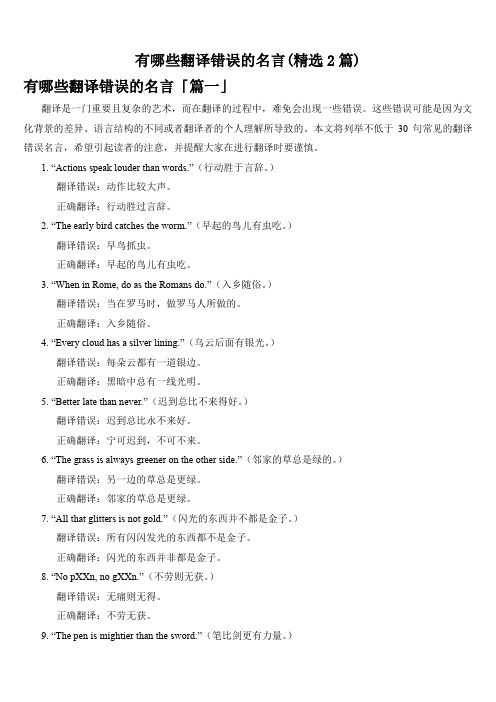
有哪些翻译错误的名言(精选2篇)有哪些翻译错误的名言「篇一」翻译是一门重要且复杂的艺术,而在翻译的过程中,难免会出现一些错误。
这些错误可能是因为文化背景的差异、语言结构的不同或者翻译者的个人理解所导致的。
本文将列举不低于30句常见的翻译错误名言,希望引起读者的注意,并提醒大家在进行翻译时要谨慎。
1. “Actions speak louder than words.”(行动胜于言辞。
)翻译错误:动作比较大声。
正确翻译:行动胜过言辞。
2. “The early bird catches the worm.”(早起的鸟儿有虫吃。
)翻译错误:早鸟抓虫。
正确翻译:早起的鸟儿有虫吃。
3. “When in Rome, do as the Romans do.”(入乡随俗。
)翻译错误:当在罗马时,做罗马人所做的。
正确翻译:入乡随俗。
4. “Every cloud has a silver lining.”(乌云后面有银光。
)翻译错误:每朵云都有一道银边。
正确翻译:黑暗中总有一线光明。
5. “Better late than never.”(迟到总比不来得好。
)翻译错误:迟到总比永不来好。
正确翻译:宁可迟到,不可不来。
6. “The grass is always greener on the other side.”(邻家的草总是绿的。
)翻译错误:另一边的草总是更绿。
正确翻译:邻家的草总是更绿。
7. “All that glitters is not gold.”(闪光的东西并不都是金子。
)翻译错误:所有闪闪发光的东西都不是金子。
正确翻译:闪光的东西并非都是金子。
8. “No pXXn, no gXXn.”(不劳则无获。
)翻译错误:无痛则无得。
正确翻译:不劳无获。
9. “The pen is mightier than the sword.”(笔比剑更有力量。
)翻译错误:笔比剑厉害。
正确翻译:笔胜过剑。
10. “Actions speak louder than words.”(行动胜于言辞。
- 1、下载文档前请自行甄别文档内容的完整性,平台不提供额外的编辑、内容补充、找答案等附加服务。
- 2、"仅部分预览"的文档,不可在线预览部分如存在完整性等问题,可反馈申请退款(可完整预览的文档不适用该条件!)。
- 3、如文档侵犯您的权益,请联系客服反馈,我们会尽快为您处理(人工客服工作时间:9:00-18:30)。
最为经典的公示语翻译错误
2012-12-11 16:59
假设你在浙江东部一沿海城市游玩,突然看到一个上面写着“码头进口Quay Import”的标牌,你会怎么做呢?是拿起相机把它拍下来,还是继续向前寻找与之相对的另一块牌子?就我而言,我是两者兼顾,不仅拍了第一块牌子,而且还费劲周折找到“Quay Export”,并把它拍了下来。
因为这些可谓是最为经典的公示语翻译错误。
看了这样的翻译,大家也许想问这样两个问题:这些公示语到底是谁翻译的?他们是怎么翻的?细细一想,我敢肯定的是这些人只是随手拿起一部汉英词典,翻到“出口”条所在的页码,然后不管三七二十一随便照搬了一个义项,于是就有了quay export的笑话。
其实,类似的错误在全国各地到处可见。
例如,在安徽泾县桃花潭风景区(标牌上的译名为“Peach blossom deep pool scenic spot”)中,近出口的一处停车场被翻译成“Exports parking lot”。
又如,在浙江桐庐瑶琳仙境,“由此出口”被译成了“From this exports”。
令人啼笑皆非的“出口”翻译还有两个:一个是“exportation”,另一是“outlet”。
前者不足为奇,因为它同样可在汉英词典中的“出口”条下找到。
就后者而言,若放在几百年前,它还是说得通的,因为在现代英语初期,outlet也可以被解释为“a passage or way out, an exit”(即“出口”),而如今这样的用法已经被淘汰。
不过,outlet现在的确还可以表示“way out”的意思,但它通常用来指代水或蒸汽,如an outlet for water(排水孔)。
假如我们打开一部汉英词典,然后翻到“出口”条下,我们还会惊喜地发现与exit、way out 同义的还有一个叫做outgo的词语。
确切地说,outgo与上述的outlet在一百多年前是同义词,因为在《牛津英语大词典》中outgo的第四义项被解释为“outlet, means of egress”(egress为正式用语,表示“外出”的意思)。
类似“出口= export”的错误也时常出现在其他汉语多义词的翻译中。
例如,在汉英词典中,“足下”有两个义项:一是“you (a polite form of address to a friend)”;二是“underfoot”,然而在上述瑶琳仙境的一洞穴中,“注意足下”却被译成了“Pay attention to you”,简直让能人笑掉大牙。
英语中的一词多义现象同样也会带来类似的问题。
例如,appeal一词有“恳求”、“有吸引力”、“上诉”等意思,然而在上海一家大医院中却出现了Appealing Reception(投诉接待)的可笑标牌用语。
一则,appeal加上-ing只有一个意思,那就是“吸引人的”;再则,“投诉”与“上诉”相差甚远,它通常用complaint来表示。
公示语翻译中另一类较为明显的错误则是由字面直译造成的。
例如:“黄昏恋”通常被译作“love between old people”或看似更为地道的“twilight love”,然而在温州雁荡山景区,“黄昏恋”却成了“sunset love”。
尽管twilight love在国内的大多数汉英词典中成了“黄昏恋”最标准的译法,然而它在英文中好像并不多见。
twilight的确可以用作形容词(如表示“黄昏的”、“模糊的”等意思),然而它却很少与love搭配使用。
看来twilight love 已成为Chinese English中一个典型词语。
